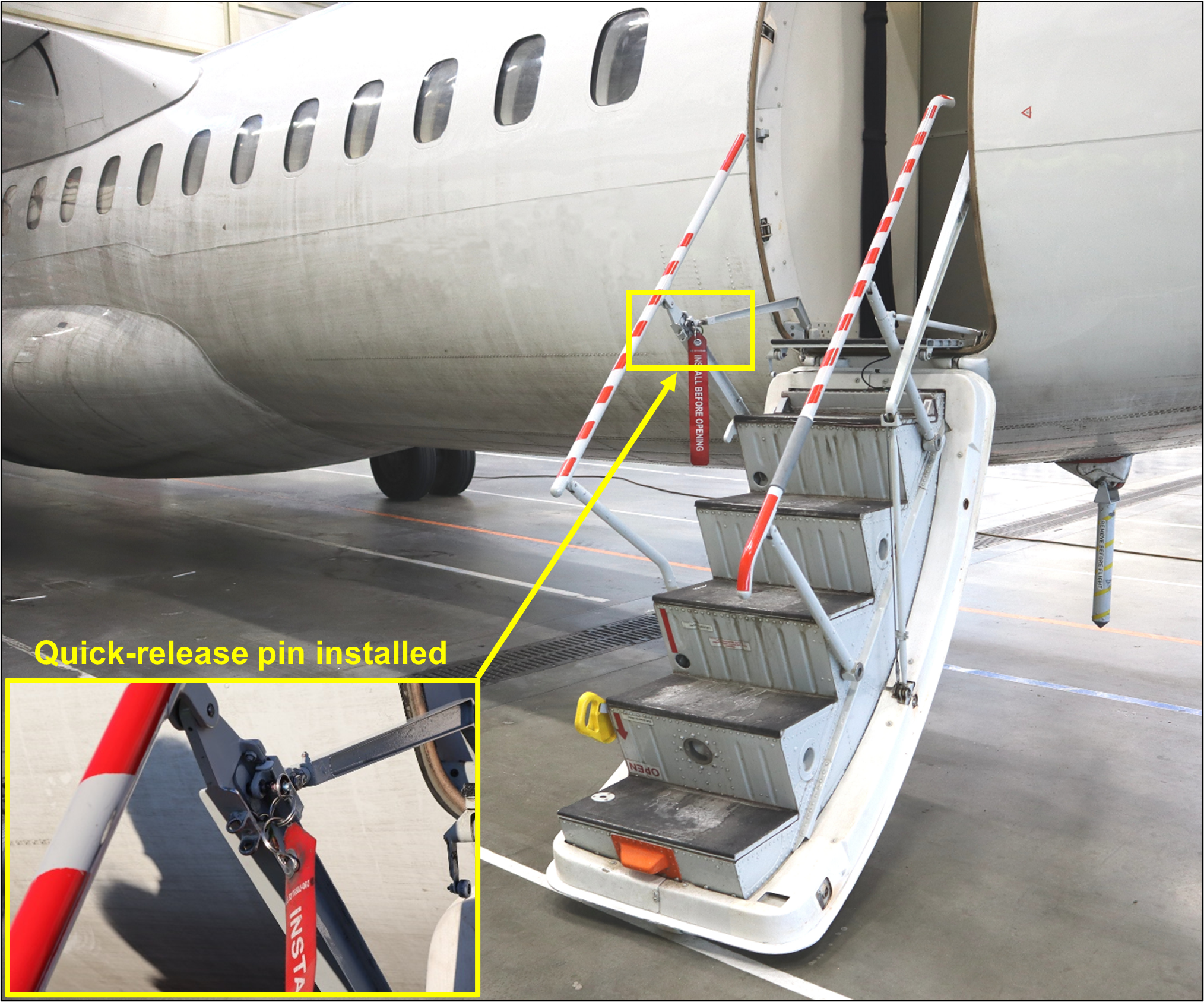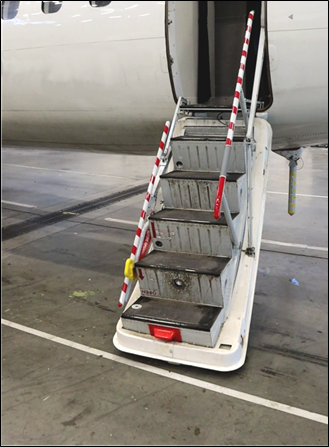Preliminary investigation into passenger
falling accident at Jyväskylä airport on January 12, 2024
The Safety Investigation Authority Finland (SIAF) has conducted a preliminary investigation into an accident that occurred at Jyväskylä airport at approximately 0100 h on January 12, 2024, when a disembarking passenger fell to the apron from the door of an airplane. The accident resulted from the unintentional collapse of a passenger steps handrail.
FACTUAL INFORMATION
Scheduled Finnair service AY289 from Helsinki, operated by Nordic Regional Airlines (Norra), landed at Jyväskylä at approximately 0050 h on January 12, 2024. Once the ATR 72-500 twin turboprop was parked on the apron, the engines were shut down at approximately 0100 h.
A member of ground staff went to knock on the passenger door to indicate that the cabin crew was cleared to open the door. This is a normal procedure.
Because the door was not opened immediately, the knock was repeated. The cabin crew member in the rear of the cabin was waiting for the seat belt signs to go out before opening the door.
The cabin emergency lights illuminated momentarily during engine shutdown. Once normal lighting was restored and the seat belt signs were turned off, the cabin crew member opened the door.
The door incorporates integral steps with handrails. The handrails appeared to have deployed normally after the door had reached the open position, and passengers began to disembark. The first passengers to leave the airplane did not use the forward handrail as support. The handrail yielded slightly as one passenger went down the steps, but the passenger quickly pulled it back to the upright position.
The fifth passenger arrived at the door carrying a coat and baggage in the left hand. The passenger grasped the forward handrail at a distance of approximately 30 to 40 cm from its upper end and proceeded to go down the steps. At that moment, the handrail collapsed without warning. The passenger lost balance and fell from the uppermost step to the apron head and flank first.
The cabin crew member’s view towards the door was blocked by a passenger. Therefore, the cabin crew member did not see the accident, but heard the sound of a fall.
A member of ground staff working at the baggage hold door at the front of the airplane and the fourth exited passenger noticed the event immediately and went to assist the fallen passenger. They were joined by another passenger and the other member of ground staff. The members of ground staff reported the occurrence to the emergency response center (ERC) at 0103 h, and the ERC dispatched a paramedic unit to the airport.
Meanwhile, the cabin crew member stationed in the rear of the cabin notified other crew members of the event. Noting that the forward handrail had collapsed, the cabin crew member raised and secured it to the upright position. The remaining passengers disembarked normally.
The fallen passenger was taken to the terminal building to wait for the the paramedic unit, which arrived at 0133 h and transported the passenger to Hospital of Central Finland to receive further medical attention.



BACKGROUND INFORMATION
Passengers enter and leave the ATR 72 via a door located at the rear of the airplane on the left-hand side. The door incorporates steep steps with a handrail on each side (figure 1).
For normal boarding and disembarkation, a cabin crew member inserts a quick-release locking pin into the mechanism of the forward handrail and then opens the door. For emergency disembarkation, the pin is left in its stowage bracket, and the handrail collapses when the door is opened to allow expeditious evacuation (figure 2). The rear handrail erects automatically when the door is opened.
Cabin crew procedures include a specific check to verify that the quick-release pin is correctly inserted into the handrail mechanism and the handrail is locked in the upright position before passengers are cleared to use the steps. The correct locking of the pin should always be checked by pulling on the handle located at the end of the pin. The pin shall remain in place when pulling force is applied.
The procedures also emphasize that a damaged or incorrectly installed pin may allow the handrail to collapse and result in injuries to passengers.
Door operation and related procedures are covered annually in cabin crew’s refresher training.
The quick-release pin conforms to the applicable MS standard. A red warning flag, approximately 40 cm long, is attached to one end of the pin.
During flight, the pin is stowed in the vertical position in a bracket at the top end of the upper handrail support (figure 3). It shall be removed from the bracket after landing and inserted horizontally into a hole located in the handrail mechanism stanchion approximately 5 cm from the stowage bracket. This action locks the mechanism, and the handrail deploys and is secured in the upright position when the door is opened.
Before departure, the pin is transferred from the stanchion to the stowage bracket.
The airplane manufacturer's maintenance documentation does not include a description of the correct function of the handrail. Neither does it contain a functional test procedure and related maintenance requirements.
Little information is available of similar incidents involving ATR airplanes. However, in 2016, the airplane manufacturer issued All Operators Message AOM 42/72/2016/11, which was subsequently updated in 2018. The bulletin describes cases where the quick-release pin had migrated away from the locked position, which resulted in injuries to passengers. After the bulletin was issued, changes were introduced to door procedures and airplane operators were prompted to replace quick-release pins by pins fitted with a modified mechanism without undue delay. Norra has complied with these recommendations.
FINDINGS
The SIAF conducted an extensive review of passenger door operation on Norra's ATR 72 fleet and discovered that the mechanism of the forward handrail on the occurrence airplane did not function correctly. When the door was opened, the handrail deployed almost normally although the quick-release pin was not inserted into the stanchion. Putting weight on the handrail caused it to collapse, as it had done during the accident sequence.
It was also discovered that the position of the warning flag is nearly identical in all configurations, i.e., with the door open or closed, or with the quick-release pin in the stowage bracket or in the stanchion. Therefore, visual observation of the flag does not give a reliable indication of the safe or unsafe condition of the handrail.
Investigation also found out that the cabin crew member forgot to lock the handrail mechanism while opening the door, leaving the quick-release pin in the stowage bracket.
Possible factors contributing to this lapse were confusion caused by the sound of knocking on the door and the momentary illumination of the emergency lights. The time of the day could also have affected the cabin crew member's alertness.
The accident was possible because the handrail mechanism was stiff, and the handrail therefore remained in the upright position and appeared safe to use. The proximity of the correct and incorrect quick-release pin positions makes visual determination of the locked or unlocked condition of the handrail difficult.
The investigation revealed that failures to install the quick-release pin correctly during door opening are not exactly uncommon, but since they largely go unreported, inputs needed to initiate corrective actions are not received. One possible improvement would be to move the stowage bracket to a location where the incorrect position of the pin would become immediately apparent during door opening. Also, the maintenance of stiff handrail mechanisms should be a low-threshold operation, because a well-maintained unlocked handrail collapses easily, thereby reducing the risk of falling accidents. It would also operate as designed in an emergency.
Cabin crew instructions for door operation and the use of the quick-release pin do not follow a practical sequence, and therefore are not conducive to the learning of an unambiguous and logical procedure.
The SIAF decided not to initiate a safety investigation into the event because it was considered unlikely that this would yield significant additional safety information. However, since the similar door mechanism is fitted in both ATR 72 and ATR 42 airplanes, which are used extensively for commercial air transport, the SIAF would like to address the following safety observations:
- The airplane manufacturer (ATR) should establish requirements for the maintenance and the verification of the correct function of the handrail.
- Airplane operators should amend maintenance schedules to ensure that the forward handrail mechanism is continuously maintained in the correct operating condition and operates without undue stiffness.
- The awareness of airplane crew members and maintenance staff of the possibility of stiffness that could appear in the mechanism is increased. Any such occurrences should be reported as a defect.
- The reporting threshold should be further lowered in order to ensure comprehensive dissemination of information of various safety occurrences also to aircraft manufacturers.
- Cabin crew instructions for door operation and the use of the quick-release pin should be reviewed and clarified.
Additional information:
Chief Air Investigator Mr. Janne Kotiranta: tel. +358 29 515 0703
Published 16.4.2024
